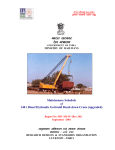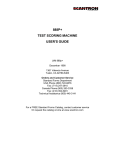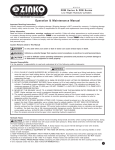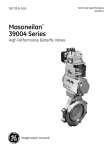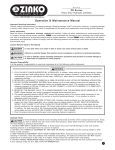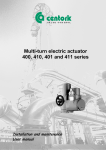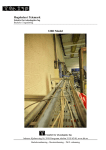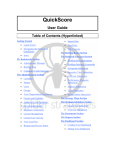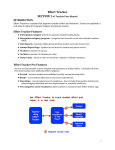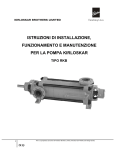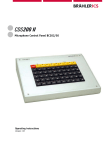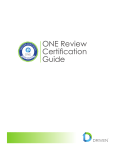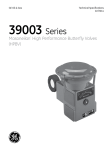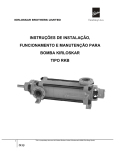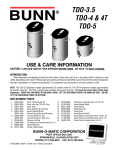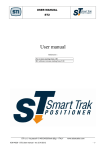Download Catalogue
Transcript
User Manual VALVE/ACTUATOR SYSTEM CONTENTS SECTION 1 PRELIMINARY INFORMATION 1.1. How to use this manual 1.2. How to order spares SECTION 2 ORDER, SUPPLY & SYSTEM DETAILS 2.1 Order details 2.2 Scope of supply 2.3 System drawings SECTION 3 COMPONENT MANUALS (Manuals for only those system components actually ordered, marked ‘ ’ are included in this manual set) 3.1 ACTUATOR ACT 3.2 PROCESS VALVE VLV 3.3 SOLENOID VALVE SOV 3.4 LIMIT SWITCH UNIT LSB 3.5 POSITION TRANSMITTER & INDICATORS PTR 3.6 I / P CONVERTOR IPC 3.7 POSITIONER POS 3.8 AIR TANK ATK 3.9 MANUAL OVER-RIDE UNIT MOR 3.10 OTHER PNEUMATIC ACCESSORIES AFR QEV FCV ALV NRV ACC 3.11 PNEU. LOCK EQV ELC ELECTRONIC CONTROLS A. O. NO. : P A G E NUMBER 1 User Manual VALVE/ACTUATOR SYSTEM PRECAUTION ! READ THIS MANUAL THOROUGHLY BEFORE ATTEMPTING TO INSTALL OR SERVICE THIS EQUIPMENT. ! PAY CAREFUL ATTENTION TO THE PRECAUTIONARY INSTRUCTIONS GIVEN AT VARIOUS PLACES IN THE USER MANUALS IN OUTLINE BOXES. SECTION 1 PRELIMINARY INFORMATION 1.1 Section 3 contains separate manuals for each major component of the valve / actuator systems supplied under this order. Each user manual is complete with respect of the system component it covers. It includes detailed specifications, standard drawings, and instruction, disassembly, re-assembly, and trouble shooting. How to use this manual Section 1 of this manual contains instructions relating to how to use this manual, ordering spares. Contact your nearest branch of our headquarters if you require : - Service Assistance - Spare parts - Actuators or valve / actuator systems 1.2 How to order spares : Spares for El-o-matic Actuators and valve actuator systems can be ordered through the El-o-matic Branch office nearest to you. Section 2 gives details which are specific to this order: Customer's order reference, our works reference, and scope of supply. Drawings of the valve / actuator systems supplied are also given in this section. PLEASE FOLLOW PART NUMBERS AND PART NAMES ACCURATELY AS GIVEN IN THE USER MANUALS. OTHERWISE, IT CAN LEAD TO ERRORS AND / OR DELAYS IN EXECUTING ORDERS. SECTION : 1 INFO P A G E NUMBER 2 User Manual PNEUMATIC ACTUATOR IMPORTANT : READ THIS MANUAL THOROUGHLY BEFORE INSTALLATION OR SERVICING CONTENTS : 1. DESCRIPTION 2. SPECIFICATIONS 3. ORIENTATION 4. AIR SUPPLY 5. OPERATION 6. MANUAL OPERATION 7. AIR CONSUMPTION 8. MAINTENANCE 9. RECOMMENDED SPARES/REPAIR KIT 10. DISASSEMBLY 11. REASSEMBLY 12. TROUBLE SHOOTING 13. P SERIES: ACTUATOR DIMENSIONS 14. P SERIES: CONSTRUCTION, PARTS AND MATERIALS 15. E SERIES: ACTUATOR DIMENSIONS 16. E SERIES: CONSTRUCTION PARTS, AND MATERIALS 1. DESCRIPTION : El-o-matic Pneumatic Actuators are pneumatic quarter turn (90°) actuators, Special versions are available for half turn (180°) applications. The design utilizes a double rack and single pinion. A unique patented features of the actuator is the application of a 3 point support for pistons. Three carbon filled Teflon guide bands are a balanced piston and the cylinder walls which eliminates wear and increases the actuator life. The bottom mounting pad of the actuator is as per ISO 5211. Thus it can be directly mounted on any valve which conforms to ISO 5211 flange configuration. Details relating to dimensions, assemblies, part list, and materials are given in the drawings / data sheets in sections 13, 14, 15 and 16. 180° actuators are available only in the' P series. (Type PD and PE). Dimensions of 180° actuators correspond to those of 90° actuators. Torque ratings of 180° actuators are different. The unit has an extended top shaft and a complete modular design which allows simple attachment to a variety of control accessories. 2. SPECIFICATIONS : P SERIES 1. Pressure range 2. Torque : PD - 0.2 to 10 bar PE - 6 to 10 bar standard springs PE - 3 to 10 bar, reduced springs 5. Temperature : -20° C to + 80° C 6. Rotation Counter-clockwise to open, with port “ A” pressurized. : : 23 to 4955 Nm, at 6 bar working pressure Spring return actuators air fail to close, clockwise 3. Media : Air (dry or lubricated) non-corrosive gas or light hydraulic oil 7. Movement 4. Construction : Suitable for indoor or outdoor Installation 8. Lubrication : Actuator size (PD or PE) Bore Stroke Weight PD PE Operating time (standard) Port A Air Consumption (actual volume at 1 atmosphere) Port B SECTION : 3.1 : 91.5° from - 0.5 CW to 91° CCW Factory lubricated for the normal life of the actuator. 37.6 1100 210 50.3 2500 300 56.8 4000 325 81.7 14.0 19.2 22.4 33.4 30.8 41.5 64.7 97.9 97.8 143.0 3.4 4.2 4.8 6.0 7.0 12.0 Units mm mm kg kg sec. 1.50 1.60 1.90 2.50 3.20 4.20 4.20 5.40 8.00 9.30 13.50 17.50 Litres Litres 60 80 18.8 150 110 25.1 280 135 31.4 500 164 37.6 750 200 2.6 3.0 5.3 6.4 9.2 11.6 1.2 2.3 0.27 0.38 0.60 0.80 ACT P A G E NUMBER 1 User Manual PNEUMATIC ACTUATOR E SERIES 1. Pressure range : ED ES ES : : : 0.2 to 10 bar 6 to 10 bar standard springs 3 to 10 bar, reduced springs 2. Torque : 9 to 251 Nm, at 6 bar working pressure 3. Media : Air (dry or lubricated) non-corrosive gas or light hydraulic oil 4. Construction : Suitable for indoor or outdoor Installation Actuator size (ED or ES) Bore Stroke 12 46 12.6 ED 0.61 Weight ES 0.67 Operating time (Standard) 0.4 Air Consumption Port A 0.05 (Actual volume at 1 atmosphere) Port B 0.06 5. Temperature : -20° C to +80° C 6. Rotation : Counter-clockwise to open with port “A” pressurized. Spring return actuators air fail to close, clockwise 25 56 15.7 1.3 1.7 0.5 0.10 0.11 7. Movement : 91.5° from -0.5° CW to 91° CCW 8. Lubrication : Factory lubricated for the normal life of the actuator 40 70 18.8 2.0 2.6 0.7 0.16 0.22 3. ORIENTATION : 200 110 37.7 6.8 10.3 2.3 0.80 1.00 350 145 37.7 10.4 16.9 3.6 1.80 1.90 600 175 44.0 19.4 27.6 3.6 2.90 3.10 950 200 50.3 26.4 38.6 5.4 4.70 4.90 1600 Units 230 mm 62.8 42.7 65.8 6.9 7.30 8.00 mm Kg Kg Sec Litres Litres 4. AIR SUPPLY : The actuator is normally installed with its major axis parallel to the pipeline. The actuator can be oriented above, beside or beneath the valve without affecting its operation. El-o-matic actuators are factory lubricated. For optimum operation, the use of clean, dry air / gas is recommended. Lubricated air is not necessary. Standard double acting actuators require 1 to 8 bar air supply pressure and spring return actuators 3 to 8 bar. The unique full machined shaft and square drive mounting pattern .allows reorientation of the actuator to accommodate installations where physical obstructions might otherwise be prohibitive. 5. OPERA TION : The El-o-matic actuator drive shaft rotates through a full 90° (180° actuators are available on special order). Rotation is accomplished by feeding supply air into the center chamber (through port A) forcing the two opposing pistons outward, resulting in counterclockwise rotation of the drive shaft to the 'Open' position. All El-o-matic actuators feature a blow out proof shaft design. This means that the pistons must be removed before the shaft can be reoriented. A A B ACTUATOR ASSY. MODE-A SPRING TO CLOSE - CW SECTION : 3.1 100 91 25.1 3.7 5.0 1.2 0.35 0.49 FIG. 1 ACT B ACTUATOR ASSY. MODE-D SPRING TO OPEN - CCW P A G E NUMBER 2 User Manual PNEUMATIC ACTUATOR For double-acting actuators, closure is obtained by feeding supply air into the end cap chambers (through port B) which forces the pistons inward, resulting in clock-wise rotation of the drive shaft. All actuators are supplied with sufficient lubrication for their normal working life. If required, recommended lubricant for all standard actuators is GREASE SERVOGEM 2. Consult El-o-matic for lubricants used for high or low temperature applications. For spring return actuators, closure is accomplished by means of springs contained in the end cap chambers, which force the pistons inward when the supply air to the center chamber (port A) is allowed to exhaust. Depending upon the conditions under which the actuator must work such as extended duty, noncompatible operating media, or abnormal operating conditions, periodic replacement of internal seals is recommended. Repair kits containing all necessary seals can be ordered from El-o-matic. To reverse the stroke direction of the actuator, remove both the pistons, rotate them by 180° and re-install. This will reverse the direction of rotation of the output shaft. (see FIG.1). On spring return actuators, the springs may need replacement after extended duty, since springs may be subject to fatigue. 6. MANUAL OPERATION : In the event of air failure, the actuator can be cycled manually. This is accomplished by applying a wrench to the exposed top shaft of the actuator and turning it in the desired direction. This is not recommended on Model PD 500 and larger size of actuators. For these, El-omatic offers, optional Manual Override gear units, with declutchable hand wheels. Manual wrench is not recommended for spring return actuators. SPRINGS SHOULD ALWAYS BE REPLACED IN COMPLETE SETS ONLY ! Spring kits are available from El-o-matic. 9. RECOMMENDED SPARES / REPAIR KIT : All soft seals, bearings and non-reusable parts are included in the recommended spare part kit. CARE MUST BE TAKEN TO ENSURE THAT THE ACTUATOR IS NOT OPERATED AUTOMATICALLY THROUGH AIR SUPPLY WHILE MANUAL OPERATION IS BEING PERFORMED! Each kit includes: Guide band, piston Guide band, housing O-rings, piston O-rings, endcap O-rings, shaft Guide bush, shaft Bearing band, shaft Washer, shaft Circlip, shaft Passage O- rings Air must be allowed to exhaust from the actuator for manual operation. This may call for disconnecting air lines or providing three-way vent valves at inlet ports, depending on the pneumatic circuits. 7. AIR CONSUMPTION : The charts showing the amount of air consumed per 90° of stroke in litres / stroke are given in specifications above. The spare parts kit is identical for both the doubleacting and the spring return models. For the spring return models, it is safe to have a set of spare springs for each different model in addition to the recommended spare parts kit. Keep in mind that, when necessary springs are to be replaced in complete set. 8. MAINTENANCE : THE ACTUATOR MUST BE ISOLATED BOTH PNEUMATICALLY AND ELECTRICALLY BEFORE ANY MAINTENANCE IS CARRIED OUT! Racks are not recommended for replacement, instead, piston-rack assemblies should be replaced, if required. Periodic checks should be performed to make sure that all fasteners remain tight. SECTION : 3.1 2 nos. 1 / 2 nos. 2 nos. 2 nos. 2 nos. 1 no. 1 no. 1 no. 1 no. 2 / 4 nos. ACT P A G E NUMBER 3 User Manual PNEUMATIC ACTUATOR 10. If converting over to a 'high temperature' actuator, or rebuilding an existing one, consult El-o-matic for proper high temperature silicone or graphite base grease. 10. DISASSEMBLY : Before disassembling any actuator, be sure that the complete repair kit is available and that the kit has been checked for all parts. 11. REASSEMBLY : 1. Disconnect the air supply and electrical service to the actuator. DOUBLE ACTING ACTUATOR 1. Replace the top and bottom shaft bearings. 2. Remove the actuator from its mounting bracket. 2. Replace the shaft in the body through the bottom of each actuator body. The bottom hole in the actuator body is larger inside diameter than the top hole in the body. DISASSEMBLY AND REASSEMBLY OF THE ACTUATOR MUST BE DONE IN CLEAN, DUST FREE ENVIRONMENTS! BALL VALVES AND PLUG VALVES CAN TRAP PRESSURIZED MEDIA IN THE CAVITY. ISOLATE THE PIPING SYSTEM IN WHICH THE ACTUATOR VALVE ASSEMBLY IS MOUNTED AND RELIEVE ANY PRESSURE ON THE VALVE 3. Very carefully align the shaft square to the body. 4. Align the pinion gear so that the teeth on the center gear will 'pick-up' the piston assembly's rack teeth, when turning the top extension of the center gear clockwise (CW). 3. Remove solenoid valve by unscrewing the mounting screws. Take care to retain the solenoid valve O-rings. 5. To ensure proper meshing of the teeth, rotate the center gear 45° (or two teeth) counter clockwise (CCW) from its normal position with the piston assemblies located at the body ends. Normal positions is that position which provides the proper output shaft orientation required. 4. Each endcap is fitted into the body with a set of end cap bolts. Remove all endcap bolts from both endcaps by loosening them evenly and a little at a time. After the screws are removed, gently pry off each endcap being careful not to damage the endcap O-rings. 6. With the piston assemblies in the body, gently push each piston into the body. Turn the top shaft extension clockwise (CW). At the proper point of engagement between the center gear and piston assemblies, both piston assemblies will move toward the center of the body when turning top shaft extension of the actuator clockwise (CW). IF THE ACTUATOR IS A 'SPRING RETURN’ MODE, UNIFORMLY LOOSEN ALL END CAPS . SCREWS ON EACH END CAP TWO TO THREE TURNS AT A TIME, IN SEQUENCE, TO RELIEVE PRE-LOAD OF THE SPRINGS. ON ALL ACTUATORS WITH SPRINGS, USE CAUTION WHEN REMOVING ENDCAPS ! 5. The two pistons can now be removed by rotating the actuator shaft, driving the piston assembly outward until the gear rack and pinion have disengaged. 7. Once the pinion gear and pistons are properly engaged, ensure that smooth movement and 90° operation can occur without moving the pistons out of the actuator body. This is important. 6. Remove and discard circlip and the washer from the shaft. 8. Take care of seal O-rings while replacing the actuator endcaps. 7. Remove the shaft through the bottom of the body. 9. Replace the washer over the top shaft extension. 8. All repair kit O-rings, guide bands and bearings may now be installed, if all the actuator surfaces are clean and free of grit and scratches. If the inside wall of the body is scored, the actuator will leak after Rebuilding. New 'unscored' parts should be obtained from the factory. Light tracing, barely detectable to touch is acceptable. 10. Install the NEW circlip into its mating groove on the top shaft extension. (The removed shaft clip is not to be re-used). When properly installed, the shaft clip should rotate freely within the groove. 9. Lubricate the standard actuator thoroughly with grease Servogem 2. Apply a light film of grease to all O-rings. SECTION : 3.1 ACT P A G E NUMBER 4 User Manual PNEUMATIC ACTUATOR SPRING RETURN ACTUATOR : E SERIES (Model ES). P SERIES (Model SR) 11. When replacing spring return actuator, ensure that the springs are replaced in their identical position in the end cap from where they were removed. 18. When replacing ES springs in a spring return actuator, ensure that the springs are replaced in their identical positions in the spring pack from where they were removed. When less than the standard number of seven springs are used in each end cap, these springs should be positioned in balanced configuration (refer FIG. 2 below) 19. If a spring return actuator is being repaired due to a failed spring, replace ALL springs in this actuator as well as any other parts which may have been damaged. 20. To change springs, open the endcaps, remove nut cover, locknut, washer and O-ring. 21. Remove the spring retaining socket bolt using a hexagon wrench. 4 SPRINGS 6 SPRINGS 8 SPRINGS 10 SPRINGS 12 SPRINGS 14 SPRINGS = SPRING. 22. Remove and (if necessary) replace springs as indicated by the spring return torque chart. Be sure that all springs are located correctly in the end cap and the spring pack retainer. (FIG. 3) FIG. 2 SPRING SET 1 INNER SPRING SET 2 MIDDLE SPRING SET 3 INNER + MIDDLE PE SERIES ACTUATOR 12. If a spring return actuator is being repaired due to a failed spring, replace ALL the springs in this actuator, as well as any other parts which may have been damaged. SPRING SET 4 INNER + OUTER FIG. 3 = SPRING. 13. When replacing the springs, place the actuator body on a clean, flat surface. Position it so that it stands on one end. Ensure that the pistons are stroked fully inward toward the center of the actuator. This may be done by rotating the actuator shaft with a wrench. ES SERIES ACTUATOR 23. Repeat steps 20 to 22 for the other spring pack. 24. Re-assemble in reverse order. (FIG. 1) CAUTION ! 14. Place the springs on the piston face, engaging them with the bosses cast into the piston. When spring return actuators are used in a highly corrosive atmosphere, or when installed in the open, there are chances of corrosive media or water entering during suction through the silencer / breather provided on the spring chamber port (Port 'B'). This may lead to corrosion to springs or excessive wear and early failure to piston sealing ring. 15. Place the endcap over the springs. Align them with the corresponding bosses on the endcap. 16. Place the endcap bolts through the retention holes of the endcaps. To avoid such problems customers are advised to use BREATHER BLOCK. Breather block avoids suction of atmospheric air into spring chamber (Port 'B'). During spring stroke it allows air from centre chamber (Port 'A') to fill the spring chamber and then exhaust to atmosphere. IF CONVERTING A DOUBLE ACTING UNIT TO SPRING RETURN, BE SURE TO USE NEW END CAPS. 17. Engage the bolts with the tapped holes in the actuator body by forcing down slightly on the cap. Tighten each bolt in SMALL and EQUAL turns. SECTION : 3.1 SPRING SET 5 SPRING SET 6 MIDDLE + OUTER INNER + MIDDLE + OUTER ACT P A G E NUMBER 5 User Manual PNEUMATIC ACTUATOR 12. TROUBLE SHOOTING : 2. If solidified grease between the pinion and the piston racks is present, clean, dry, regrease and reassemble. ACTUATOR For identification of all numbered parts refer to drawing numbers in sections 14 and 16. 3. Verify that the actuator pinion shaft and / or pistons are bound. If bound, reassemble following the rebuilding Instructions. AN ACTUATOR SHOULD NEVER BE REMOVED FROM THE SERVICE(PROCESSVALVE UNDER ! PRESSURE Make sure that all internal port passages are clear and free of any obstructions. 4. If the actuator exhibits excessive amounts of backlash, check teeth in piston racks for wear. If worn, replace piston gear rack assembly. Make sure that the actuator is lubricated, and that there is no solidified grease between the pinion and the piston racks. 5. In spring return actuators, check for misplaced or broken springs. If springs are broken, check the body bore for Scoring. 1. If the actuator has no lubrication, apply generous amounts of grease. If the actuator is for high or low temperature operation, consult El-o-matic for proper lubricant. SECTION : 3.1 ACT P A G E NUMBER 6 User Manual PNEUMATIC ACTUATOR ACTUATOR SYSTEM IMPORTANT: READ THESE GUIDELINES BEFORE ATTEMPTING ANY REPAIRS SR. NO. FAULT A. FOR SOLENOID OPERATED ACTUATORS : 1. Actuator does not function. PROBABLE CAUSE REMEDIAL ACTION Valve jammed / seized. Check valve operation through Wrench / Manual Override (MO), if provided otherwise, remove actuator and check valve for smooth operation. Excessive friction in valve gland. Check gland packing, loosen gland if required. Solenoid valve not operating / Functioning Check solenoid coil and ensure that specified supply voltage is applied to coil. Air supply not reaching actuator Check solenoid valve operation (listen for “click” sound). Replace coil / valve if not functioning. Check pneumatic line and connections. Check air after regulator setting (use local pressure. gauge for checking supply pressure). SECTION : 3.1 Insufficient air supply pressure Check air supply pressure and ensure specified air supply pressure. Manual Override engaged in manual mode (where MO is mounted) Declutch manual override and disengage handwheel. Equalizing valve open (if provided only for system with MO). Check equalizing valve and close valve fully before giving air supply. Speed control valve (regulating valve) fully closed (for system with speed control valve) Check position of speed control valve. Ensure that valve is kept partially opened. Actuator undersize for the given application. Cross check valve torque requirements. Select correct size of actuator. ACT P A G E NUMBER 7 User Manual SR. NO. 2. 3. FAULT Actuator functions but exhibits lack of power Full stroke of actuator not achieved SECTION : 3.1 PNEUMATIC ACTUATOR PROBABLE CAUSE REMEDIAL ACTION Leakage in pneumatic line. Check all pneumatic connections and tighten properly. Use Teflon tape / thread sealants on threads. Leakage across pistons or between ports A & B (can happen only due to prolonged operation over a period of time) Pressurise port A/B and check for leakage from the others. Change sealing parts if required Low air supply pressure. Check supply pressure and ensure correct air supply pressure. Severe misalignment between actuator and valve Check linkage. loosen mounting bolts and align actuator correctly for friction free rotation. Excessive friction in gland packing Check gland and loosen if required. Excessive clearance / play in adaptor / linkage Change adaptor. Mounting bolts loose or wrongly Oriented Align correctly and tighten bolts. Limit stops on actuator (if provided, not set correctly) Check and reset limit stop screws to achieve required stroke. Limit stops on MO (incase of systems with MO) not set properly. Check limit stop settings on MO and readjust if required to achieve full rotation. Obstruction in valve or linkage. Check for mechanical obstructions if any and remove Excessive spring torque (in case of spring return actuators). Low air supply pressure. Check air supply pressure and ensure specified supply pressure. Check spring selection. ACT P A G E NUMBER 8 User Manual SR. NO. 4. PNEUMATIC ACTUATOR FAULT Noise inside actuator PROBABLE CAUSE REMEDIAL ACTION Improper clearance between rack and pinion. Broken or loosened rack bolts. Open actuator and check tightness of rack bolts. If loose tighten properly. If worn out replace racks /shaft. Insufficient lubrication . (due to prolonged use at high ambient temperatures.) Open actuator, clean and lubricate with specified lubricant/grease. Metal to metal contact due to Replace guide bands / sealing worn out sealing / guiding elements. elements. B. ACTUATORS CONTROLLED WITH POSITIONERS (Additional checks ) 5. Actuator not functioning on increasing signal pressure 6. Incorrect positioning SECTION : 3.1 Leakage in signal line signal not reaching Positioner. Check signal line fittings and tighten properly. Check for blockage in signal line. Insufficient supply air pressure Check and ensure specified air supply pressure Faulty Positioner / seized spool valve Check and repair (See Positioner instruction manual) or replace Positioner Feed back mechanism not functioning / broken Check Positioner feed back linkage ensure positive feed back. Excessive play in feed back mechanism Check linkage and connect properly. Tighten grub screws provided on adaptor. Wrong span and zero adjustment. Check span and readjust to obtain specified span. Correct zero Adjustment. Wrong selection of feed back cam profile Check selected cam profile and ensure that the required profile only selected. ACT P A G E NUMBER 9












